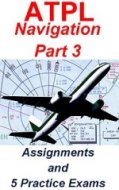

 |
 |
|
Aircraft Flight Planning Topic 12.
CP position given GW/Winds, and Distance data only.
|
Critical points also go by the names “Equi-time Point” (ETP), and “Point of Equal Time” (PET). A variation on the critical point theme can be where you are given minimal information, including GW at the CP, wind forecast data (grib winds), and the departure and destination airports. There are only three things that effect the position of any CP. They are ... 1. The wind at the level(s) the aircraft will go ON at, or return HOME at. This is found by using the GW at the CP, and working out maximum FL ON, and maximum FL HOME. 2. The performance of the aircraft (ie: it’s TAS). Low TAS moves CP more into wind from half-way than does a high TAS, because with the low TAS you are effected by the wind for a longer time. 3. The distance between the airports. Firstly, the CP is ALWAYS into wind from half-way, due to the bias of the groundspeeds. As Australia is located in a region of mid-latitude westerly winds at altitude, it is likely the CP will be west of half way. You can eliminate any answers that are downwind of half way, or exactly halfway. Secondly, you must use the TAS for the CP operation concerned. That is, use the normal ops TAS for normal CP’s (typically 470 kt for B727), the 1 Engine Inop TAS for a 1 Inop CP (typically 410 kt for B727), and the Depressurised TAS for CPDP (typically 370 kt). Thirdly, the TAS and FL used OUT to the CP does NOT enter into this calculation. That is for a PNR, but NOT CP. An example: Find the position of the CP1 Inop expressed as a distance from the departure airport (A), given ... Track (mag)/Distance Airport A to airport B is 300M/820 nm. Inop TAS 410 kt (B727). GW at 1 Inop CP 75, 000 kg. Wind at 1 Inop level 270M/60 kt/ISA+10. Working: 1. Use the GW of 75, 000 kg and the 1 Inop level ISA deviation of +10, to get max altitude capability ON and Home. For the purpose of the exercise, I have given the wind/temp that would have been found on the Grib (RSWT) wind forecast data supplied in an exam. The highest FL ON and HOME is FL240 ON, and FL230 HOME. Use the FL235 wind data, which for this exercise is the one given in question above. 2. Head wind ON is 52 kt, and tail wind HOME 52 kt. 3. Using the CP formula, and a groundspeed ON of 358 kt/GS HOME of 462 kt, you get a position 52 nm into wind (west) of half-way, which is 462 nm from departure airport. NOTE: In CP calculation you must average the wind components ON and HOME to get the correct answer. For the B727 at typical mid zone weights, the FL235 reported winds/temps generally apply to CP 1 Inop. Just get the average track at mid point in the journey, add up the various wind directions and speeds, and divide by the number of wind blocks to get useable average data. Get an average wind component and use it in formula. Best wishes Rob Avery
|
